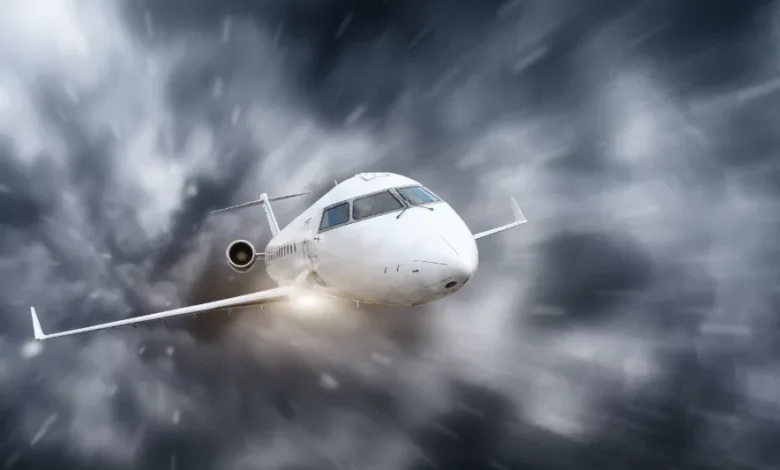What’s in-flight turbulence and when is it harmful?


This file photograph exhibits an airplane in the sky. A number of turbulence-impacted flights have been reported this year.
A Delta Air Traces flight from Salt Lake City to Amsterdam that was hit by severe turbulence on Wednesday, July 30, 2025, sending 25 folks on board to hospitals and forcing the flight to divert to Minnesota, highlighted the risks of flying via unstable air.
A number of turbulence-impacted flights have been reported this year.
Whereas turbulence-related fatalities are fairly uncommon, the tally of accidents has grown through the years. Some meteorologists and aviation analysts notice that studies of turbulence encounters have been rising and level to what local weather change could be doing to flying situations.
Planes hitting bumpy air is generally minor, nevertheless, and airways have tried to enhance security. Specialists advise vacationers to remain vigilant, stressing carrying a seat belt every time possible.
What’s turbulence?
Turbulence is basically unstable air that strikes in an unpredictable manner. Most individuals associate it with heavy storms. However, probably the most harmful is clear-air turbulence, which frequently happens with no seen warning.
READ: Turbulence: What it is, why it occurs
Clear-air turbulence occurs most frequently in or close to the high-altitude rivers of air known as jet streams. The offender is wind shear, which is when two enormous air masses come to one another and move at completely different speeds. If the distinction in pace is sufficiently big, the environment can’t deal with the pressure, and it breaks into turbulent patterns like eddies in water
How pilots attempt to keep away from turbulence
Pilots attempt to keep away from turbulence partly by utilizing a weather radar display. Generally, they will merely see and fly around thunderstorms.
However clear-air turbulence “is altogether one other animal,” stated Doug Moss, a former airline pilot and security advisor. It may be devastating, he stated, “as a result of the time earlier than the incident may be very calm, and individuals are caught off-guard.”
Air visitors controllers will warn pilots after one other aircraft runs into clear-air turbulence, Moss stated. Many pilots additionally search for indicators of wind shear, then plan to keep away from these areas, he stated.
Fashionable planes are robust sufficient to deal with nearly any turbulence. Cabin areas corresponding to overhead bins could obtain beauty injury; “however, these don’t influence the structural integrity of the planes,” Moss stated.

It’s unclear how widespread accidents are
Monitoring the variety of turbulence-related accidents worldwide is troublesome. However, some nations publish nationwide information.
Most studies of in-flight turbulence from 2009 to 2018 resulted in a number of severe accidents and no injury to the aircraft, the Nationwide Transportation Security Board reported.
Between 2009 and 2024, 207 people have been injured severely sufficient during turbulence to require hospital treatment for a minimum of two days, in accordance with the NTSB. Most of them have been flight attendants, who usually tend to be out of their seats throughout a flight.
What vacationers can do to remain protected
In brief, buckle up. Turbulence may be difficult to foretell; however, specialists stress that the primary line of protection is maintaining the seat belt fixed, every time.
And airways have taken steps for security. Last November, Southwest Airlines stated it was ending cabin service earlier in order that passengers could return to their seats and fasten their seat belts sooner.
The change was meant to “cut back the chance of in-flight turbulence accidents,” the corporation stated.
Additionally, last year, Korean Air decided to cease providing a beloved instant noodle, Shin Ramyun.
“This determination is a part of proactive security measures in response to elevated turbulence, geared toward stopping burn accidents,” the Seoul-based airline stated in a press release.
Latest flights shaken by turbulence
In June, 5 folks were taken to a North Carolina hospital for analysis after an American Airlines flight from Miami hit turbulence on its way to Raleigh-Durham Airport. The aircraft landed safely.
Earlier that month, extreme storms in southern Germany pressured a Ryanair flight to make an emergency touchdown after violent turbulence injured 9 people, German police stated. The flight was touring from Berlin to Milan with 179 passengers and 6 crew members. Eight passengers and one crew member were injured.
In March, a United Airlines flight from San Francisco to Singapore experienced extreme turbulence over the Philippines. The aircraft was carrying 174 passengers and 14 crew members. 5 people were injured, and the aircraft landed safely in Singapore.
A number of flights have been diverted to Waco, Texas, on March 3, due to turbulence. 5 folks were injured aboard a United Specific aircraft flying from Springfield, Missouri, to Houston.
Final year, Italian authorities launched an investigation after two easyJet flight attendants were injured when their flight from Corfu to London’s Gatwick Airport was buffeted by turbulence. The pilot made an unscheduled touchdown in Rome.
In May 2024, a 73-year-old British man died and dozens of individuals were injured aboard a Singapore Airlines flight that hit extreme turbulence. His death was under investigation. Authorities stated he could have had a heart attack.
Local weather change’s effect
Some scientists notice that studies of turbulence encounters are on the rise. A number of researchers have pointed to potential local weather impacts as one of many possible explanations.
Professor Thomas Guinn, of Embry-Riddle Aeronautical College, explains that some predict local weather change may alter the jet stream and up the wind shear, which might drive up turbulence.
Paul Williams, a professor of atmospheric science at the College of Studying in England, stated there was “robust proof that turbulence is rising due to local weather change.”
Williams stated in a press release last year that his analysis crew found that extreme clear-air turbulence within the North Atlantic has increased by 55% since 1979, for instance. The crew’s projections sign that extreme turbulence within the jet streams may double or triple within the coming many years if international situations proceed as anticipated, he stated.
There could possibly be an increase in general air visitors, which will improve turbulence encounters because the variety of flight tracks goes up, stated Larry Cornman, a undertaking scientist at the National Science Foundation’s Center for Atmospheric Research.
READ MORE: LAD REPORTING




